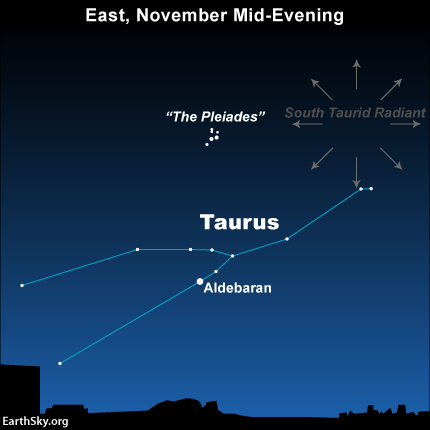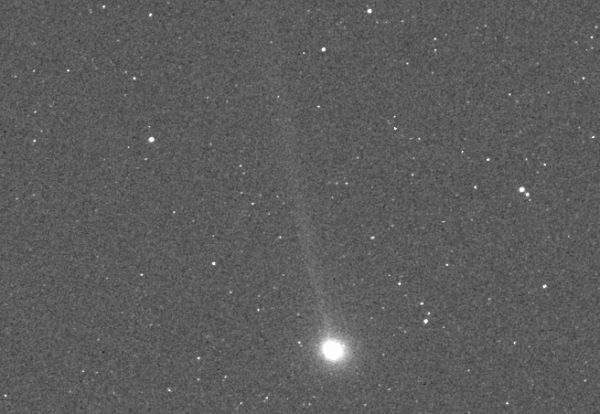

Taurid fireball through light clouds – November 1, 2018 – by Eliot Herman in Tucson, Arizona. Notice the moon, just rising, on the left.
The South and North Taurid meteor showers aren’t known for their large numbers of meteors, but they do offer a high percentage of fireballs, or exceptionally bright meteors. This shower made a huge splash four years ago, in 2015, when there were many, many reports and photos featuring Taurid fireball sightings. Higher rates of Taurid fireballs appear to happen in seven-year cycles. Grand fireball displays did indeed take place in 2008 and 2015. No elevated levels of fireballs are expected in 2019. Even so, watch for Taurid meteors – and possible fireballs – throughout November.
The nominal peak night for the South Taurids is November 6 while that of the North Taurids is about a week later, on November 12 (the same date as the November 2019 full moon). So this year, in 2019, the first several days of November may be best for watching the Taurids, as there will be no to little moon to disrupt the show. But you might even see a Taurid or two on the night of the full moon, given the high percentage of fireballs accompanying the Taurids.
EarthSky 2020 lunar calendars are available! They make great gifts. Order now. Going fast!

Taurid fireball on the evening of October 21, 2017 – 10:27 p.m. – from Joanne West at Gold Canyon, Arizona. Eliot Herman in Tucson caught this same meteor. Read more about the 2 photos.
The prime time viewing hours are from late night until dawn, with the peak viewing coming just after the midnight hour. In general, the South Taurids offer about five meteors per hour at their peak, but the North Taurid shower may add a few more meteors to the mix. How many you’ll see will depend on how far from city lights you are … and how bright the meteors are. If they’re bright enough, they’ll overcome skies beset by light pollution.
The Taurid meteor stream consists of an extremely wide roadway of far-flung debris left behind by Comet 2P/Encke. When Earth travels through this belt of comet debris, bits and pieces of Comet 2P/Encke smash into the Earth’s upper atmosphere to vaporize as rather slow-moving Taurid meteors (28 km/17 miles per second).
Apparently, the original Taurid stream has been perturbed by Jupiter into two branches: South and North Taurids.
Bottom line: South and North Taurid meteors – some of them bright fireballs – can be seen through late October and November, each year.
Source:
https://earthsky.org/astronomy-essentials/south-north-taurid-fireballs-how-to-watch

